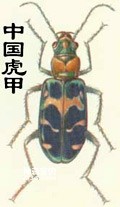The tiger carapace is golden green, copper or gray with yellow markings. The head is broad and the compound eyes are prominent. It has three pairs of slender thorax and legs, and can move quickly and flexibly. Tiger beetles are also carnivorous, often active on mountain roads or sandy areas, and can fly low to prey on small insects. Sometimes on quiet roads, when people are walking on the road, the tiger beetle is always three to five meters in front of the pedestrians, with its head facing the pedestrians. When pedestrians approached it, it flew low and backed away, still facing the pedestrians, as if it was playing with them. Because it always blocks in front of pedestrians, it is known as the "roadblock". There are about 2,000 known species in the world, and there are more than 100 species in my country. Common ones include Cicindela chinensis De Geer, etc.

Although the adult tiger beetle is very beautiful, its larvae, the camel beetle, are very ugly. But the camel bug's unique self-defense method allows us to catch "fish" on dry land and tease tiger beetles. People go fishing in ponds or rivers, which is not only a form of entertainment, but also a harvest. It can also exercise patience and cultivate sentiment. Children cannot go because it is too dangerous and they will be in trouble if they accidentally fall into the water. What should children do if they want to fish? They can go to the grass in the wild and play the "fish" game. What they actually catch are camel worms living in caves. First, look for a small hole in the grass. After finding it, gently insert a thin grass stalk into the small hole, and then observe the movement of the grass stalk. When the grass stalk swings gently, lift it up immediately and you will catch a small caterpillar with a hunchback and a bent shape - a camel worm. How can a camel insect be caught on a grass stalk without a hook or bait? This starts with the insect's self-defense behavior. When the grass stalk is inserted into the hole, the camel bug is attacked, and it defends itself by biting the grass stalk with a pair of upper jaws. At this time, as long as you quickly pull out the grass stalk, the camel bug will be pulled out.
The camel bug has a large head, a hunched chest, and a curved abdomen. It looks like a camel, with hair all over its body. The back of the fifth abdominal segment is bulging and has a pair of reverse hooks. Camel bugs live in holes dug by adults. The depth of the hole is about 33 cm and the hole opening is about 5 mm. It usually escapes to the bottom of the hole, and when hunting, it climbs up to the entrance of the hole. It uses the reverse hook on its back to fix its body, with a pair of upper jaws exposed outside the hole. It waits for the bug to crawl through the hole, suddenly attacks, and then drags the bug into the hole. This kind of "wait and wait" method of hunting will certainly not catch a lot, and it will inevitably starve at times. Once food is caught, it will be a full meal. The little camel bug is also very smart. It knows that it is not sure to rely solely on prey that falls into the trap, so it thinks of ways to lure the small animals. It gently swings its upper jaw and antennae exposed at the entrance of the hole, imitating the swinging posture of grass, thereby attracting small animals to take the bait. Although this method can achieve the effect of hunting, sometimes it will expose itself, attract natural enemies, and be eaten instead. Camel bugs also have a way of defending themselves. When it encounters a hostile attack, it relies on its curved body to quickly squirm and its long slippery hair to quickly hide in the hole. If the exposed upper jaw is dragged by an enemy, it will use the reverse hook on its abdomen and back to hook firmly on the cave wall, making it difficult for the enemy to pull it out.
Tiger beetle is a complete metamorphosis. It can use its mandibles and feet to dig holes in the ground, enter the caves at night or on rainy days, and spend most of its time outside the caves looking for prey. Mating takes place in the grass outside the cave, and eggs are laid in the cave. After the eggs hatch, the larvae live alone in the cave and rely on themselves to hunt for food. They stay in the cave throughout their childhood. When the juvenile period is about to end, it will dig another sloping hole next to the bottom of the hole, make a pupa chamber, and pupate until it emerges into an adult and crawls out of the hole to move around.
animal tags: beetle
We created this article in conjunction with AI technology, then made sure it was fact-checked and edited by a Animals Top editor.